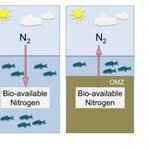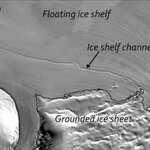Oceanography

Every organism needs nitrogen to survive and grow and many organisms do not have the ability to obtain nitrogen from molecular nitrogen (N2), the major component in the atmosphere because they lack the nitrogen fixation pathway and have to rely on supply of nitrogen that has been fixed by others.
The availability of fixed nitrogen, in the form of ammonium, nitrite and nitrate, consequently often limits primary production in the environment. That's one of the reasons why many fertilizers are rich in fixed nitrogen.
There are microbial processes that convert fixed nitrogen back to N2 (…

NASA is going to measure changes in the height of the Greenland Ice Sheet and surrounding Arctic sea ice produced by a single season of summer melt, which will give researchers a more comprehensive view of seasonal changes and provide context for measurements that will be gathered during NASA's ICESat-2 mission, which is scheduled for launch in 2016.
The C-130 with NASA research equipment on board left Wallops Island, Va., and will conduct survey flights to collect data that will improve our understanding of seasonal melt and provide baseline measurements for future satellite…

After oxygen in the atmosphere and ocean rose about 600 million years ago, earth got the first proliferation of animal life. Between then and now, numerous short lived biotic events took place when oxygen concentrations in the ocean dipped episodically.
The most studied and extensive of these events occurred 93.9 million years ago. By looking at the chemistry of rocks deposited during that time period, specifically coupled carbon and sulfur isotope data, a research team led by University of California, Riverside biogeochemists reports that oxygen-free and hydrogen sulfide-rich waters…

With 99% of the Earth's water unused, it might not seem like there could be a water scarcity issue, but water tends to be boom and bust. Many of the poorest regions don't have access to potable water and new estimates by the Potsdam Institute for Climate Impact Research (PIK) if temperatures warm due to climate change.
They estimate that mean global warming of 2 degrees, the target set by the international community, would expose an additional 8 percent of humankind to new or increased water scarcity. 3.5 degrees could affect 11 percent of the world population and 5 degrees could raise that…

Huge ice channels almost as tall as the Eiffel tower have been discovered beneath a floating ice shelf in Antarctica. They are 250 meters high, stretch hundreds of kilometers along the ice shelf, and likely influence the stability of the ice shelf.
The scientists used satellite images and airborne radar measurements to reveal the channels under the ice shelf. The channels can be seen on the surface of the ice shelf, as well as underneath, because the ice floats at a different height depending on its thickness.
The researchers also predicted the path of meltwater flowing under the…

New evidence suggests than no continental ice sheet formed during the Late Cretaceous Period more than 90 million years ago, when the climate was much warmer than it is today, though it has been commonly believed to have happened that way.
In the study, researchers analyzed the fossilized shells of 90 million-year-old planktic and benthic foraminifera, single-celled organisms about the size of a grain of salt. Measuring the ratios of different isotopes of oxygen and carbon in the fossils gives scientists information about past temperatures and other environmental conditions.
The…

Mild winters in Northern Europe are thanks to the Gulf Stream, which makes up part of those ocean currents spanning the globe that have always impacted the climate.
Yet our climate is also influenced by huge eddies, black holes of turbulence over 90 miles in diameter, that rotate and drift across the ocean. Their number is reportedly on the rise in the Southern Ocean, increasing the northward transport of warm and salty water. A good thing, because this could moderate the negative impact of melting sea ice in a warming climate.
Yet quantifying their impact so far has been difficult,…

The ice sheet on West Antarctica just got a little older - 20 million years or so.
The findings indicate that ice sheets first grew on the West Antarctic subcontinent at the start of a global transition from warm greenhouse conditions to a cool icehouse climate 34 million years ago. Previous computer simulations were unable to produce the amount of ice that geological records suggest existed at that time because neighboring East Antarctica alone could not support it.
Given that more ice grew than could be hosted only on East Antarctica, some researchers proposed that the missing ice formed in…

By analyzing a 150-year-old moss bank on the Antarctic Peninsula, researchers describe an unprecedented rate of ecological change since the 1960s, driven by warming temperatures.
The researchers looked to the Antarctic Peninsula because it is one of the most rapidly warming regions on Earth; annual temperatures there have increased by up to 0.56°C per decade since the 1950s. There they found a moss bank that has been slowly growing at the top surface and accumulating peat material since it first established in about 1860. By analyzing core samples of that moss bank, they were able to…

The annual melting of sea ice in the Arctic is approaching its yearly "minimum," the time when the floating ice cap covers less of the Arctic Ocean than at any other period during the year, and there is some good news - this year's summer low is not going to be too bad.
The concerning news is that this year's melt rates are in line with the sustained decline of the Arctic ice cover observed by NASA and other satellites over the last several decades.
The icy cover of the Arctic Ocean was measured at 2.25 million square miles (5.83 million square kilometers) on Aug. 21. For…